Dehydrating food is a safe and cost-effective way to increase food security, prevent food spoilage, preserve nutrients, and save money. Learn more about food dehydration and its impact on food security and nutrition here.
I bought my first food dehydrator in 1984. This was before counter top food dehydrators were a thing. It was a specialty item, handmade by a local electrician and sold only in health food stores for those who cared about health. The Berron food dehydrator was a big investment at them time. One I knew would pay for itself in less than a year.
I used it to dry our apples and pears from our back yard fruit trees, as well as drying vegetables from local farms. These dried fruits and vegetables were added to lunches, served as healthy after school snacks, and used as camping food and emergency food storage. That Berron food dehydrator is still working after almost 40 years. But in 2021 I added two new dehydrators to my food preservation arsenal — a Corsori stainless steel dehydrator that reliably dries meat at 165F and a 10 tray Excalibur dehydrator to increase my dehydrating options. Food dehydrating is even more essential with the rising cost of food, lower nutritional quality of food from the grocery store, and the threats to food security we are seeing in the world today.

What is Food Dehydrating
Food dehydrating is one of the oldest preservation methods for food. Traditionally, dehydrating was often done using sun and breeze power, in lightly shaded areas. Traditional sun-dried tomatoes are a good example of this. In North America, traditional dried food included pemmican, which involved sun and wind dried meat being combined with dried berries, and fat as an additional preservative. Smoking is another form of dehydrating, that uses the dryness of smoke and the natural compounds in hardwood smoke to help preserve food. However, this form of dehydrating is normally only done with meat.
Today, we have food dehydrators that fit on a countertop, and can be used to dehydrate everything from cheese, meat and jerky, to mushrooms, apples, peaches, mint leaves, and more. A dehydrator can save you a lot of freezer and fridge space, help preserve a harvest before it goes bad, and even lets you take advantage of sale priced fruits and veggies at farmer’s markets, or the store.

Benefits Of Dehydration
Dehydration of fruits and vegetables is a great way to preserve more flavor and vitamins than high heat canning, or pressure canning. Dehydrated fruits, prepared at the peak of ripeness, will have a similar profile to fruits frozen at the same time.
Dehydrated food can be re-hydrated for stews, soups, or for use in desserts if it’s fruit.
Dried fruits and vegetables are compact, light, and easy to carry. Things like fruit leather are a favorite of hikers, and over-night campers who need light-weight and compact foods to carry with them on the trail.

How Dehydration Works
Dehydrating removes the water from foods, preventing bacteria, fungi, and molds from growing and decomposing the food in question. Depending on the food, some have added preservatives, like the vinegar, salt, and sugar based marinades for jerky. Dehydrated food also takes up less space, and is lighter than other forms of food preservation.
Traditional all-in-one dehydrators have a fan to circulate air, and a heating element to provide the heat. You can use an oven to dehydrate small quantities of food, to see if you like the dried form of something, before committing to buying a dehydrator.
However, a dehydrator will be more energy efficient, and convenient for food preservation than just using an oven to dry food. The newer dehydrator machines have a lot of square footage on the trays, and can dry a large amount. My personal ten tray dehydrator can hold 3-4 pounds of mushrooms on 5 trays. Those mushrooms dry to fill a single one gallon zippered bag, and can be powdered down to fit into a single pint jar. A 6-tray cabinet-style dehydrator can hold 8 pounds of fruits and vegetables easily.

Why Dehydration Is Important
Dehydrating food is one of the easiest food preservation methods and is accessible to everyone. Bunches of herbs, hung to dry in a dark space is dehydrating teas and spices. Mushrooms spread out in the sun on a screen, with fine cloth over them to protect from insects, is dehydrating food. Dehydration is accessible, simple, and easy.
The dehydration of food is possible without electricity, using simple solar and wind power. Many traditionally dried peppers, tomatoes, and other fruits and vegetables are done with minimal equipment. In cooler climates, having a dedicated electric dehydrator is convenient, easy, and safe.
Most foods need only to be washed, and maybe sliced, before being dehydrated. Meats are an exception, as the addition of salt, spices, and marinades helps preserve them as well. Even cheese can be dehydrated!

Food Dehydration For Food Security
Many of our frequent, or common, purchases are based on dehydrated foods. Onion powder is made from dehydrated onions, the same as garlic powder. Dried peas are often dehydrated peas, or mature peas that naturally dehydrated on the vine before harvest.
Dried carrots are a staple in many instant soup or instant noodle mixes, and dehydrated carrots are easy to make at home.
Any garden harvest over what you can eat fresh can be dehydrated. If you find a good buy on produce you don’t grow, it can also be dehydrated. Dehydrated food will keep for many years without refrigeration, depending on type. Meats keep for 1-1.5 years, nuts and seeds due to their fat content for about 2 years, and vegetables and fruits for 5+ years, when properly packaged. It is a great way to increase food security, by keeping the food you grow available, preserved, and usable for many more years. As long as the dried moisture content remains below 10-15% in storage, the food will keep. The shelf life of dehydrated food can be increased by vacuum sealing in jars or Mylar bags and adding an oxygen absorber packet. Optionally, if you life in a humid area, a desiccant packet can help prolong shelf life too.
Dehydrating abundance and excess can also help you keep foods like tomatoes on hand if a crop failure hits the next year. You’ll still have dried tomatoes to powder for sauces, or to hydrate in broth or water for pasta sauce, soups, stews, meat marinades and more.

Food Dehydration And Nutrition
We usually think of preserving food as lowering it’s nutritional value, unless it’s frozen. However, even with freezing and flash frozen produce, the length of storage time can still reduce the available nutrients and vitamins.
Dehydrating is more reliable at preserving the nutrition in food, once it’s in a dehydrated state. If you’re concerned about preserving the vitamin C content of fruits, doing a longer and slightly lower temperature drying time will help.
Further, storing dried foods in glass jars in a dark area, and keeping them in a low humidity environment can also help preserve their nutritive value during storage.

Dehydrated Foods Can Be Nutritious
Thankfully, unlike canning where high temperatures destroy a lot of the vegetable’s and fruit’s vitamins, dehydrated foods hold onto their nutritive value, minerals, and antioxidants.
Solar drying mushrooms can even increase their vitamin D content, as well as preserving these briefly existing delicious fungi for later enjoyment.
Dehydrated food makes one of the most nutritious options for quick on-the-road meals, for camping, hiking, or for emergency storage. These meals can be even more nutritionally dense than frozen freezer meals, since they’re prepared with ingredients preserved at peak ripeness and timing.
USDA tests demonstrate that dehydrated foods lose only 3-5% of nutritional value — mostly vitamin C and vitamin A. Compare with canning (60-80% loss) or freezing (40-60% loss). When you dehydrate your own food there are no additives or damaging high temperatures. Properly dried and stored food lasts up to five years and takes up little space. Just vacuum seal in any jar and place in a cool, dark area for long term storage.
It is also easy to make meals that fit your preferred flavor profiles, and with ingredients that you know are free from allergens, or are organic, or are from your own garden.

“Shelf Life Increase”
Dried foods have a shelf life increase over fresh and frozen foods. Frozen food remains good for only a few months before freezer burn, defrosting cycles, and time begin to reduce it’s edibility and nutritional value. While the calorie amount may be similar between fresh and frozen, the edibility of quick freeze foods will decrease after 3-6 months.
For the longest preservation of your dehydrated foods, including meats like cooked ground beef, chicken, or turkey, you can add the use of vacuum sealing mylar bags with a desiccant packet and an oxygen absorber packet. Use a vacuum sealer to keep air and potential moisture out of the bags long-term. These bags are often used for storing freeze dried foods as well, since they provide the longest shelf-life of the existing sealable storage bags.

Dehydrated Foods Are Safe To Eat
You’ve probably already eaten dehydrated food at some point in your life. Raisins are dehydrated grapes, banana chips are a camping and hiking staple. We love dried cranberries in breads, cakes, and sometimes cookies.
Dehydration removes the moisture from fresh fruit, or vegetables, herbs, and meats. This removes the environment that bacteria and mold need to grow. As long as that moisture level stays at a dehydrated level, the food will store safely. Beef jerky, green beans, blueberries, potatoes, broccoli, apricots, hot peppers, rice, quinoa, and other lean meats, can all be dehydrated to the point of preventing food contamination, and kept at that point for storage.
Dehydrated foods have lower, to nil, risk of bacterial contamination, provided that the food is wholesome to start with. Always wash and clean fruits and veggies before beginning the preservation process. Canned goods, and frozen goods, can all have mis-steps in the processing that causes contamination of some type. Dehydrated foods are inhospitable, in the extreme, to contaminants like botulism, and other bacteria, molds, and fungi.

Essential tools for dehydrating
Besides the oven or dehydrator, there are a few essential tools to make home dehydration and food preservation easy and efficient.
Cutting boards are necessary for preparing fruits, veggies, and meat for the dehydrator. A good heavy duty cutting board protects your counters, and the edges of your knife from dulling while preparing food for preservation.
Second, a good knife or several are essential. A sharp knife makes all the difference in ease of preparation. It helps avoid wrist pain, and a good sharp knife will also help you avoid getting cut. Dull knives are dangerous, so invest in a good set of kitchen knives that will stay sharp.
A sharpening stone, gadget, or burnishing rod is also essential for food preparation at home. When working with high acidity fruits or vegetables, like tomatoes, a knife will need to be re-sharpened frequently. The sharper the knife, the easier it is to slice and dice the fruits and veggies, and the faster the pre-drying preparation will go.
When drying cherries, a cherry pitter is a great tool to have on hand. A simple, mechanical, cherry pitter can save hours on cherry prep for either freezing or dehydrating. A simple pitter can be approximated using a straw, with a plastic bottle top to hold the cherry in place while stabbing it to remove the pit. However, this restricts the size of cherries that can be pitted, and if they’re too ripe or too under ripe it won’t work either.
A larger pot with a steamer basket, or colander is good for blanching, either to remove the skins from fruits or veggies, or for blanching certain veggies before dehydrating them. Foods like broccoli and cauliflower should be blanched before drying or freezing, same with sweet corn.
The colander can also be used for rinsing potatoes before drying them, or for general rinsing and washing of foods.

What Foods Should NOT be Dehydrated at Home
Never dehydrate bacon! Bacon and other high fat meats cannot be dehydrated at home, due to the fat content. The fat won’t dry out, unlike lean meat and lean protein. This is why beef jerky is recommended to have all fat removed before drying. It is also why you drain fat from ground beef, and cook it, before dehydrating it for backpacking recipes.
Avocados seem like a nice fruit to dehydrate, however due to their high fat content they will never dry properly in an air dehydrator. They can be frozen, however, for short term storage and make a good blender ice-cream.
While you can dehydrate cheese for backpacking and snacking, avoid trying to dehydrate butter. The high fat content, again, won’t let it stay preserved and will make it difficult to dry. Commercial preparations of powdered butter aren’t dehydrated, they use a different method to make it.

Top Foods Dehydrated
The top foods to dehydrate are what you have an abundance of. This could mean leafy greens and kale in early spring or late fall. It could mean bushels of apples or strawberries. If you’re in a hot growing zone, or area, it could even mean pineapple, mango, or figs.
Apples are one of the top foods you can find dehydrated. Dried apple chips are sold for hikers, backpackers, and as a healthier alternative to potato chips. Simply slice 1/4 inch thick, and dry in your dehydrator until crisp. Apples are a great introduction to dehydrating food, if you’ve never done it before.
Pineapple is a fun fruit to dehydrate, either in triangles or rounds. The rounds are quite beautiful, but the triangle form slices up faster. Simply slice 1/4 inch thick, and dry in your dehydrator until leathery and pliable.
Tomatoes and tomato skins dry well, and make a great sauce thickener. The skins are normally discarded when making and canning tomato sauce. However, they dry well, and are great for tomato powder. Tomato powder, re-hydrated, makes a good substitute for canned tomato paste. Large tomatoes can be dried by slicing 1/4 inch thick and dehydrating till crisp. Cherry tomatoes can be halved, then dried. Tomato skins can just be spread on the dehydrator racks and dried.
Peppers, either sweet or hot are a traditionally dehydrated vegetable. They are great for adding spice and flavor layers to many dishes, sauce mixes, and dried meal or soup mixes. Sweet peppers can be sliced into thin strips, and dried that way. I like to dry sweet peppers in strips and diced to have some choice when I’m preparing meals. They can be rehydrated in water before you use them to top a pizza or they can be tossed still dry into a soup stock. Spicy peppers can be sliced either into strips, dried whole and ground down with their seeds for extra hot spice, or sliced in rounds with seeds removed before dehydrating.
Carrots, broccoli, cauliflower, beets, and even potatoes may need blanching, or some cooking, before being dehydrated. You can learn more about blanching here.
Sweet potatoes, zucchini, beets, and even cucumbers can make great dehydrated chip substitutes. They also hydrate well when making soups and stews. For making chips, simply sprinkle with a favorite seasoning or spice blend and dry as normal. There’s no need to include oil when dehydrating veggies for chips.

Dehydrating Fruits And Vegetables
Apples and other fruits that change color easily on exposure to oxygen can be dipped in an antioxidant like lemon juice, or lemon juice water to prevent browning. The browning does not affect the flavor or shelf life of the dehydrated fruit, just it’s appearance.
Other fruits, like cherries and apricots do well simply sliced in half and dried. Large grapes, with seeds inside, can also be sliced in half and then dried, with the seeds removed. Strawberries do well sliced into 1/4 inch slices, if large, or just in half if small, and then dried. Raspberries can be dried whole with just minimal rinsing, however, they do dry hard and airy.
Berries with tight skins, like blueberries or seedless grapes, need a quick trip through boiling water to help with the dehydration. The skins of these berries keeps them from dehydrating well. Boil a large pot of water, and pour the berries in for 30-45 seconds, then scoop out once the skins show signs of cracking. Then transfer to dehydrator trays and dry.
Some high sulfur vegetables like kale, broccoli, and cauliflower are also blanched before dehydrating. You can completely slice and prep the vegetable for dehydrating, then blanch all at once, drain, and place on the dehydrator trays directly.
A fun thickening blend that works well with many sauces and flavor profiles is simple to make from dehydrated vegetables. I use one third each of dried mushrooms, dried zucchini, and dried tomatoes all powdered finely in a spice grinder. To thicken a liquid sauce, I add 3-6 tablespoons of the mixture, stir it in, and let it sit to hydrate. It also works well as a thickener or binder for meatballs, without the need to use breadcrumbs.
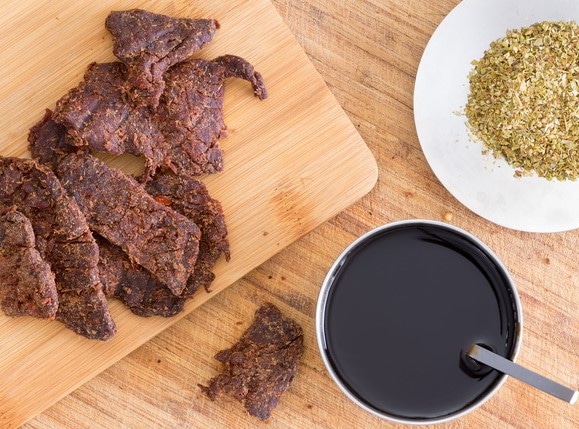
Dehydrating Fish And Meat
Lean meats and fish can be safely dehydrated. Use a temperature of 165F for raw meat and jerky or a temperature of 145F for cooked meat. Most jerky recipes call for lean meat, and a vinegar, salt, and sugar based marinade to aid in the preservation that the dehydrator gives.
Meat that is cooked and drained of fat, like ground beef, chicken, or turkey, can also be dehydrated. This meat is great to use for backpacking and traveling meals where weight is a major concern. (There are tips for making ground meat that rehydrates well, in my new book, The Dehydrator Cookbook for Beginners)
Dehydrating lean meat when you have an abundance of it, or a less expensive source, will reduce reliance on refrigerators and freezers. Dehydrating meat is a great emergency storage option, that doesn’t rely on electricity, and can be stored in a go-bag, an office closet, or workplace for when it is needed. Always store dehydrated food in a cool, dry spot to extend its shelf life.
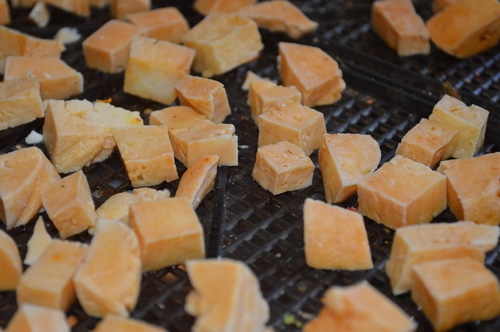
Dehydrating Dairy Products
Many people who discuss dehydrating food say to never dehydrate dairy. However, low milk-fat cheese like feta, farmer’s cheese, and other stove-top or quick cheeses actually do dehydrate well. It’s normally not recommended to dehydrate heavy fat cheeses like cheddar, as the fats can go off while the main cheese protein and sugars are still good. (For those I prefer freeze drying.)
When dehydrating cheese, cut it into small cubes or thin slices. Then dry in the dehydrator with a paper towel on the dehydrator tray. Check every 2-3 hours during the dehydrating process, and blot off any excess fats that pool on the cheese surface.
The sugars in cheeses like feta caramelize, and you end up with a chewy, sweet, chunk of cheesy goodness that is very different from the starting cheese. It goes well in slightly salty trail mixes, or can simply be stored for use in food mixes, pre-mixed “one pot” hiking mixes, and of course, just snacked on on it’s own. This is dehydrated as a snack and I don’t recommend it for long term storage.
You can even use a dehydrator to hold the temperature for making yogurt!

Dehydrating Grain
Most grains we use are dried as whole grains, often on the stalks themselves. However, grain products like crackers, can be made in a dehydrator instead of an oven.
Seed crackers, made with flax and almond flour, can be “cooked” in the dehydrator rather than baked in an oven. The result is a surprisingly crisp cracker that keeps its crispness in storage. There are other recipes too that can be cooked by dehydrating food, including dog biscuits, dog treats, and many variations of seed and cheese crackers.
The “minute rice” is actually semi-cooked rice that is then dehydrated. It “cooks” with just hot or boiling water, since the rice grains themselves were already cooked before being dehydrated. You can make your own minute rice by pre-cooking rice till it’s just fluffy and not sticking together, rinsing it, and dehydrating it. Then, simply hydrate it with boiling water, and you’ll have instant rice.
We use this as a go-lunch when we have a day of errands in the city. We add 1/4 cup dehydrated rice, 2 tablespoons dehydrated chicken, 1/4 cup mirepoix mix (dried carrots, onions, and sweet peppers), and 2 tablespoons other dried veggies to each pint size thermos jars. Fill it with boiling water to within 2 inches of the top. Tighten the lid. Give it a shake. 4 to 6 hours later its ready to eat.
You can make your own instant potatoes and instant mashed potatoes by cooking potato and then dehydrating it too. It works on the same principle as the rice. Most grains can be cooked, then dried, and used to make “instant” or quick hydrating meals that store well.

Packaging Dried Food for long term storage
Dried foods can be in glass jars or in mylar bags. As long as the container has some type of seal, it will help keep your dehydrated food fresh.
The addition of an oxygen absorber, and an optional silica desiccant packet will also preserve freshness longer. The oxygen absorbers are filled with iron powder. They work by rusting in the presence of oxygen (oxidized iron is created) thereby removing the oxygen from the vacuum sealed container. While oxygen is removed other gasses like Nitrogen remain. This increases the percentage of non-oxygen gases in the package, similar to how potato chip bags are filled with a non-oxygen gas to preserve freshness.
After dehydrating food, it can be packed in plastic zippered bags. However, the food will stay fresh longer in non breathable mylar bags, or in glass jars or containers. I would avoid plastic containers, as they don’t always have a tight seal. Plastic bags, over time, breathe and food stored in plastic will have a shorter shelf life than food stored in mylar bags or glass jars.

Preventing Food Spoilage
Dehydration is a great way to prevent fresh foods from spoiling. The drying reduces the chance for spoiling, before the food is consumed. Often, in gardening, growing apples, pears, berries, or other fruit, a large portion of the crop is ripe and ready to consume at the same time. Dehydrating, even a small portion of the crop, can reduce food spoilage and crop waste.
Further, drying portions of fruits or vegetables that are normally tossed in processing, like tomato skins, strawberry tops, or the leafy portion of celery, can reduce food waste too. This helps reduce the usable food that ends up in the compost, or trash, and repurposing this food can help reduce odors or mold in indoor air too.
The last way that dehydration helps prevent food spoilage is simple. You can dehydrate a ton of food that is on a cusp of becoming unusable due to damage, bruising, or being overripe. Locally, there is a food reclamation program at a local church, that takes in fruit and veggies from a grocery store. It is the fruit and veggies that other stores toss in the dumpster, but in the food reclamation the food is instead cooked into soup, or dehydrated to send to the regional food banks. Over 40% of the fresh fruits and veggies that come in get dehydrated, of the remaining 50% ends up in soups or fresh use from our local soup kitchen and food bank, and only about 10% ends up being sent to farmers for pig feed or worm composting.

Using Food Dehydration To Reduce Post Harvest Losses
When the entire crop of tomatoes is ready at once, dehydrating is a great way to dry what you can’t can, or may not have room to freeze. Even if you can the entire year’s harvest of tomatoes into sauce, the skins can still be dehydrated for a nutritious and flavor packed tomato powder.
Tomatoes are just one example. Berries are another, since blueberries, raspberries, cherries, strawberries, and all fruit can be dehydrated. Even herbs can be added to your list of dehydrating food. I used my dehydrator this past fall, when the killing frost was predicted, to dry all the rest of my basil, sage, and other outdoor, tender, herbs before the plants died in the frost.
Even with winter keeping food, like squash, pumpkin, cabbage, or carrots and beets, when they start looking past their prime for winter storage, they can be dried. Dried squash, carrots, and beets are great for bulking winter soups that start out too water, or for absorbing bone broth and adding flavor and nutrition.
Frequently, in November, I’ve dried the last of the winter storage apples. I’ve grated and dried mammoth zucchini in December and January because they had developed a soft spot. Dried zucchini can be powdered and use to extend flour, as well as being used as a thickener in soups and stews and other dishes.
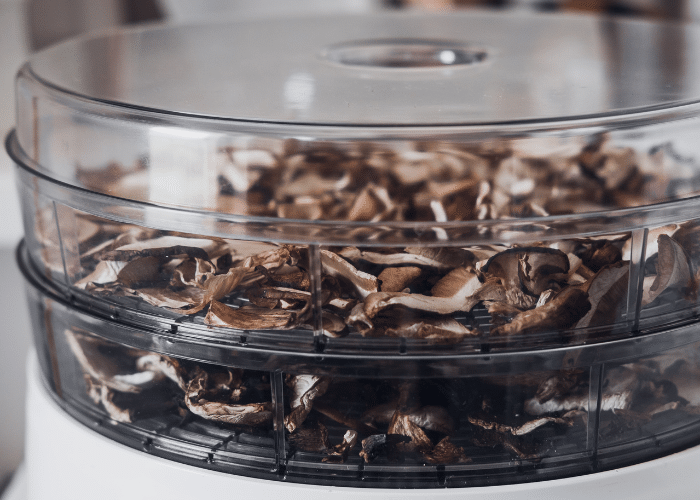
How Dehydrated Food Is Used
Dehydrated foods are used in many of the same ways their fresh counterparts are. Carrots go great in soup or stew, whether fresh or dehydrated and hydrated in broth. Slow hydration, in broth or another flavorful liquid, can help disguise dried foods in soups and stews, and stabilize the textures available.
Powdered dried veggies, like greens, are often used in green power smoothies. I love using powdered dried zucchini in sauces or as a thickener in soups. It’s nearly invisible in the food, and absorbs excess liquid without me having to cook down the soup. So it saves cooking energy too.
Dried fruit is often used as a snack food. Fruit leather, apple chips, chewy pear candy, crisp dried peaches, are all great winter snacks and can help you reduce buying imported, and out of season, fresh fruits in winter. Just remember the equivalence of dried fruit to fresh. A handful of dried plums isn’t much, until you consider that 12 dried plum halves are 6 whole fresh plums! And when enjoying dried fruit as a snack, remember to drink plenty of water to help with satiety.
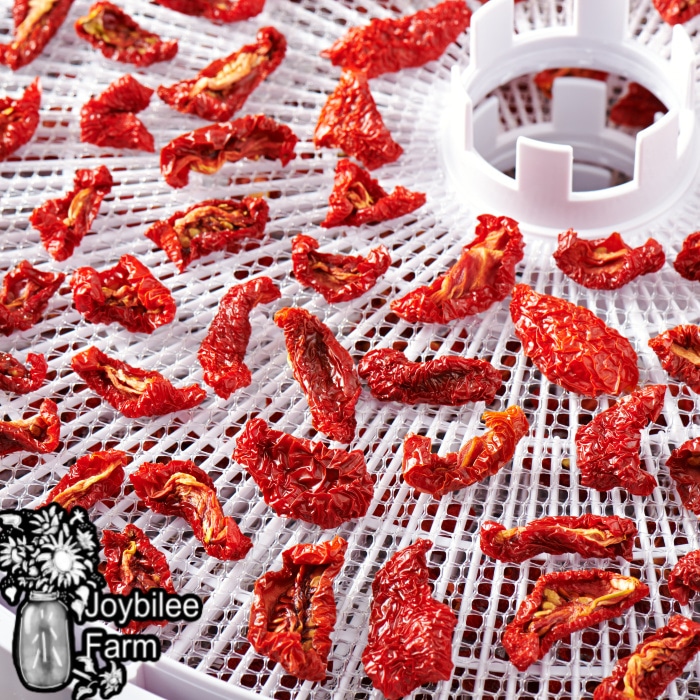
How Safe Is Dehydrated Food?
As long as food remains dry, and is fully dried before storage, dried food will remain safe. Dehydration is one of the oldest, and most reliable and accessible food preservation methods, with a strong record of safety.
Mold and bacteria cannot grow without moisture. As long as soft, bruised, or damaged spots are removed from food before drying. And as long as the food remains dry in storage, home dehydrating food will make it as safe and store-able as any commercially dehydrated food.
Of course, following proper food preparation methods helps keep food safe in storage too. Washing food, to remove spores, bacteria, and potential chemical drift or residues helps with food safety. Removing bruises, cutting off damaged areas, and not drying any foods with visible mold will also help keep your home dried food safe.
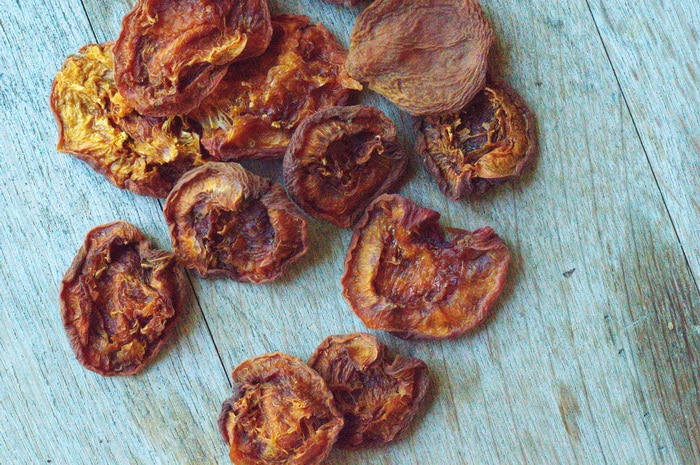
Food Dehydration Methods
In general, dehydrating needs low relative humidity, and free air circulation. There are many methods of drying, however the ones using a dedicated dehydrator will give you the most peace of mind. Electric dehydrators make efficient use of electricity and can speed up food drying with their integrated fans and temperature controls.
The commercial dehydrators provide peace of mind, low relative humidity, and good air circulation along with a heater to counteract any humidity in the local air. However, air drying and sun drying are still viable options, with the addition of trays and mosquito style netting. Even a microwave oven could be used, though I don’t recommend this as the center of the food can overheat while other parts of the food are still cool.
Herb bundles in a warm, indoor room, with good air circulation is a simple way to bulk dehydrate herbs. However, putting herbs in a dehydrator also works very well if you keep the temperature around 95F. Spreading herbs on a cookie sheet in a vented oven can also let them dry faster than just bundling and hanging them.
The key is to use the dehydration method you feel comfortable with, and that’s most accessible to you, for the vegetable, fruit, herb, or other food abundance you have.
Many of the currently made dehydrators contain built in thermostats, and timer regulation. So besides making sure to have silicon mats for the dehydrator trays for making fruit leather, or other more liquid items, the newer dehydrators come with everything you need for dehydrating food successfully.
If you’re starting out working with your oven, an independent oven thermometer can help for dehydrating jerky and other meats. These small, independent thermometers help make sure the internal temperature of the drying meats get high enough for preservation, even with the door of the oven slightly ajar for humidity regulation.
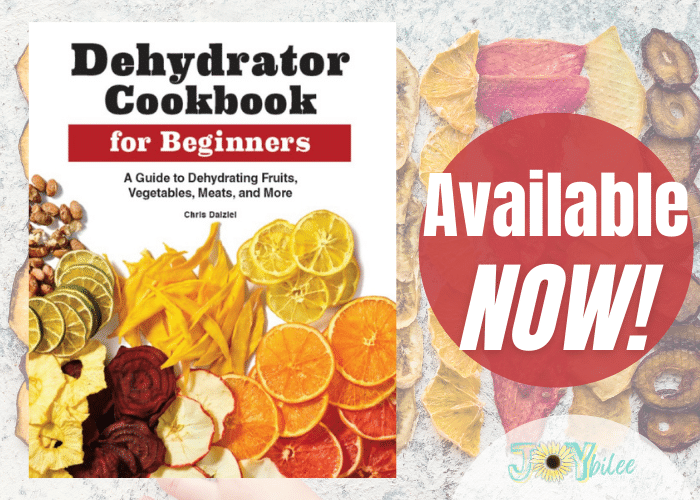
Dehydrating Food Made Simple:
Want to delve deeper into the do’s and don’ts and fun of dehydrating food? My new book, Dehydrator Cookbook for Beginners: A Guide to Dehydrating Fruits, Vegetables, Meats, and More, is available for pre-order! My dehydrating cookbook takes you through the whole process step by step, from ensuring that your food is safe for dehydration to sealing in the maximum nutrients and flavor—no experience required.
Dive into dehydrating food:
- What’s dehydrating, anyway?—Learn the basics of how dehydrating works, and the essential tips and tools you need to get started with your dehydrator.
- Dehydrating from A to Z—Discover how to properly dehydrate fruits and veggies, meat and fish, and even herbs and spices.
- Meals, snacks, and sides—Put your newfound knowledge to the test with recipes for classic dried foods like Kale Chips and Apple Leather, and full meals like Shepherd’s Pie and Curry Chicken with Rice.
- Pro-tips on food preparation, rehydration, and using your dehydrated food to boost flavor and nutrition.
Start drying your own food today with the Dehydrator Cookbook for Beginners.




I have two that I’m very happy with. One is an excalibur 10 tray dehydrator. The other is a less expensive, but just as reliable Corsori.
Very interesting article. Thank you. I bought the book. Any suggestions on dehydrators?